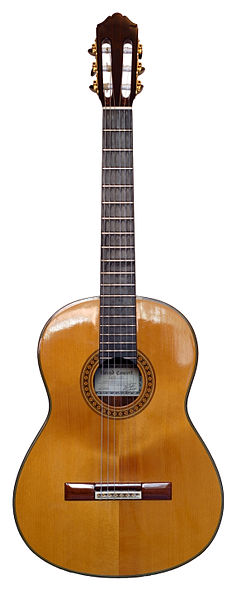Parlor or parlour guitar usually refers to a type of acoustic guitar smaller than a Size No.0 Concert Guitar by C. F. Martin & Company. Mottola's Cyclopedic Dictionary of Lutherie Terms describes the term as referring to "any guitar that is narrower than current standards."
Parlor guitars in 19th century: Washburn Parlor Guitar (1894) Washburn "New Model" (1896)
Spanish-style (c.1845) / Size No.3 (3-17) (1859) guitars by C. F. Martin
Very first Size No.1 guitar with earliest X-Bracing (1842) by Martin & Schatz
c.f. Size No.0 (0-45) guitar played by Joan Baez
An acoustic guitar is a musical instrument in the string family. When a string is plucked, its vibration is transmitted from the bridge, resonating throughout the top of the guitar. It is also transmitted to the side and back of the instrument, resonating through the air in the body, and producing sound from the sound hole. While the original, general term for this stringed instrument is guitar, the retronym 'acoustic guitar' – often used to indicate the steel stringed model – distinguishes it from an electric guitar, which relies on electronic amplification. Typically, a guitar's body is a sound box, of which the top side serves as a sound board that enhances the vibration sounds of the strings. In standard tuning the guitar's six strings are tuned (low to high) E2 A2 D3 G3 B3 E4.
Image: Classical Guitar
Image: Martin HD28
A reconstruction of a medieval gittern, the first guitar-like instrument
Basic anatomy of a classical guitar








